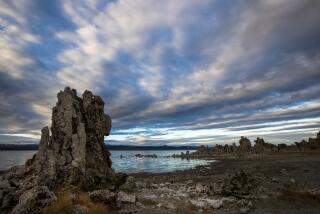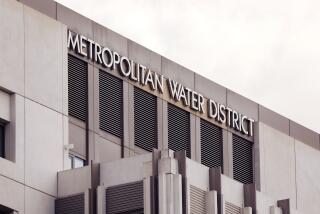Water Rights Could Sink Valley Secession
Lurking beneath the rhetoric about San Fernando Valley secession is a cold fact: According to many experts, if the area leaves Los Angeles, it goes without its water rights, and without water, the Valley is just another patch of dusty savannah dotted with bunch grass.
That does not mean the Valley would dry up and blow away. But it does suggest that the new city and the one it would be leaving would be intertwined in an enormously complex division of assets, and that the Valley would probably remain reliant on Los Angeles for its survival.
The stakes of the water issue are so profound that top Los Angeles officials have already begun investigating the implications of San Fernando Valley secession, and some have tentatively concluded that the resulting mess would be so complicated that it would effectively squelch secession.
“This,” said one top city official, “is by far the most complicated issue for secession. It’s huge.”
Unsurprisingly, not everyone agrees.
Larry Calemine, executive director of the Los Angeles Local Agency Formation Commission, was unavailable for comment Thursday, but he recently told the Metro Investment Report, a local public policy newsletter, that dividing the region’s water would not kill secession.
“The water was bought and paid for by the city of Los Angeles--and isn’t the San Fernando Valley part of the city of Los Angeles?” he told that publication. “I can’t understand why a subdivision of the city would have any impact on water issues.”
But within City Hall, some officials all but chortle over the complications that they believe the water issue will erect for secessionists.
“I’m sure they will be horrified to learn that they may be able to take the land, but to take the water, they’ll need to come back to us,” City Councilwoman Ruth Galanter, whose committee oversees the city’s Department of Water and Power, said of secession advocates.
Despite court cases over the years that have reinforced Los Angeles’ rights to its water, some of those who have called for a study of secession argue that the city would not retain its water rights in the event of a municipal divorce.
“It is our opinion that the water rights should be divided,” said Jeff Brain, president of Valley Vote. “They should be divided just like the rest of the assets and liabilities of the city.”
Brain and others believe that the new city should get its proportional share of the water rights. With that, the Valley city could then decide to run its own water system.
Supplying Water to the Valley
But nothing is simple when it comes to California water. Other experts dispute that view, vigorously contending that nothing the Valley does can strip Los Angeles--whatever its borders--of its water rights. They argue that the DWP might continue to supply Valley residents with their water--in part because state law would not allow the department to turn its back on existing customers just because they live in a breakaway area.
Under that approach, Valley residents would continue receiving water, but Los Angeles, not the new city, would own the water supply and the new municipality would have to contract with Los Angeles to get its share.
That is the opinion of David Hotchkiss, an assistant city attorney who recently studied the question at the request of Mayor Richard Riordan’s office.
“While the city of Los Angeles may not be divested of its ownership interests in water obtained via the Los Angeles Aqueduct, the Department of Water and Power may be required to continue to provide water to existing customers, including those who may secede from the city of Los Angeles,” Hotchkiss concluded in an opinion dated Feb. 5 and obtained this week by The Times.
Previous attempts to challenge Los Angeles’ water rights have failed, Hotchkiss noted in his opinion.
“The city has withstood all legal claims to the water contained in the aquifer of the San Fernando Valley, which contains both indigenous water and that imported from the Eastern Sierra via the Los Angeles Aqueduct,” he wrote.
In other words, the new Valley city would not even necessarily own the water beneath its own streets because the rights to it were granted to the original Pueblo de Los Angeles by the king of Spain. And it is one of the peculiarities of water law that such ancient claims still carry weight.
If the DWP were asked to supply the new city with water, that would run into its own troubles. The DWP was established by the city of Los Angeles for one purpose: to supply the residents and businesses of Los Angeles with water. If the Valley leaves, the Los Angeles City Charter prevents the DWP from selling the new city water.
Presumably, state law would then take force, and Valley residents would argue that they are entitled to equal treatment, even though the city they would be leaving is the one that went out and secured that water at considerable expense and controversy.
What does all that mean? At a minimum, it means that the “independent” Valley city would sit at the end of Los Angeles’ water pipe. Or, if it strove for a cleaner break, the new city would be forced to turn to other sources to quench its thirst.
There are, in theory, other possible suppliers: The Valley could buy its water from the Metropolitan Water District, the mammoth agency that supplies most of the region. That would give the Valley genuine water independence from Los Angeles--although it would still be required to reimburse the city for its pipes, water treatment plants and other facilities.
New Sources Could Be Costly
But independence would come at a steep price. MWD water is much more expensive than DWP water, mainly because the MWD has to pump its supplies all the way from the Colorado River, while much of the DWP water runs downhill from the Eastern Sierra. What’s more, the MWD already overdraws the Colorado River, and adding the entire Valley to its system would leave it perilously vulnerable in droughts.
Still another option is that the Valley could go shopping for another supplier, much as San Diego has done in contracting to buy water from the Imperial Valley. But San Diego’s experience is instructive. Even with a willing buyer and seller, that city’s deal is expensive and politically volatile. Closing it has been so difficult that Gov. Pete Wilson has recently intervened in an attempt to settle the dispute.
Adding to the irony is the fact that much of the Valley was originally annexed into Los Angeles precisely because of the water. That was in the early 1900s, when an aggressive civic elite in Los Angeles secretly bought up water rights in the Owens Valley and built an aqueduct to bring that water hundreds of miles south. That water made development of the Valley possible--and, incidentally, enriched the men who engineered the scheme.
When that water was first secured, the Valley was not part of the city. It was annexed soon after. That reinforces the argument of secession opponents who say that the Valley’s right to the water began when it joined Los Angeles and would end if it left.
“We went out and got that water,” said one Los Angeles official. “The Valley exists because we got it. Now if the Valley wants to go, and if it can get the votes, OK. But it’s still our water, and it’s going to stay that way.”
(BEGIN TEXT OF INFOBOX / INFOGRAPHIC)
City Water Sources
On average, 41% of L.A.’s water goes to the San Fernando Valley. The Department of Water and Power gets water from the Los Angeles Aqueduct, local ground water and the Metropolitan Water District--which draws from the Sacramento Delta and Colorado River.
The DWP’s sources:
TYPICAL YEAR
Los Angeles Aqueduct: 65%
MWD: 20%
Ground water: 15%
****
1996-97
Los Angeles Aqueduct: 70%
Ground water: 18%
MWD: 12%
****
1998-99 (PROJECTED)
Los Angeles Aqueduct: 77%
Ground water: 17%
MWD: 6%
Source: L.A. Department of Water and Power
More to Read
Sign up for Essential California
The most important California stories and recommendations in your inbox every morning.
You may occasionally receive promotional content from the Los Angeles Times.











